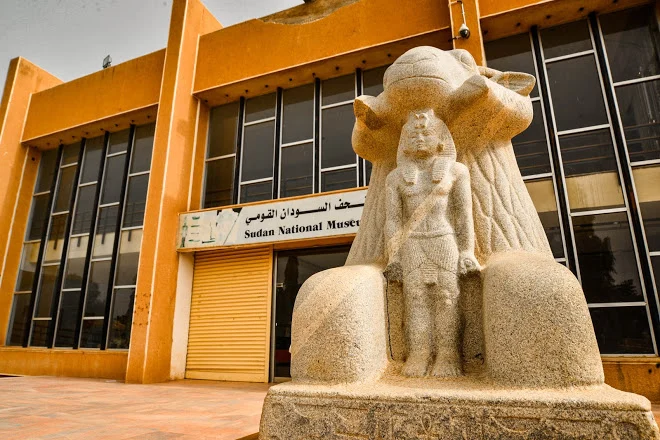The Antiquities of Sudan: The Past and Future in the Face of the Present

Sudan Events – Agencies
A new and tragic diaspora for Sudanese antiquities is unfolding, but this time it leads into the unknown. In the 1960s, UNESCO’s campaign saved the Nubian antiquities from being submerged by the waters of the High Dam, although much of Sudan’s proud history was engulfed. The National Museum in Khartoum was established as the faithful guardian of what remained of these historical treasures. Over the decades, the museum’s collection expanded to tell stories from every era and corner of the country. Before the recent outbreak of war, the museum was preparing for a transformative project, one that reimagined Sudan through new halls adorned with golden treasures and rare mummification artifacts. As the statue of Taharqa was poised to take its place at the heart of the main hall, the museum closed, awaiting a bright future. But the Sudanese soon awoke to a horrific nightmare: the theft of antiquities. One year and five months after the war began in Khartoum, under the watchful eyes of the Rapid Support Forces occupying the museum’s buildings, the dream turned into a tragedy, making headlines.
A year has passed since August 2023, amid complete silence from officials and museum staff about the theft of archaeological artifacts from the storerooms of the Sudanese Antiquities and Museums Authority. Hope was pinned on recovering the looted items away from the media’s eyes, to avoid alerting antiquities smugglers that they were being pursued by local and international authorities. The museum’s director, Dr. Ikhlas Abdul Latif, confirmed that the looting of the National Museum’s contents began in August 2023, following the Rapid Support Forces’ takeover and continued presence in the area.
In an interview with “Atar,” historian Dr. Marwan Nasr Al-Din emphasizes that a people who neglect their history are a severed people, doomed to repeat the mistakes of their ancestors. He references what European nations did during the world wars when they hid their cultural heritage to protect it and safeguard their identities from looting and destruction. This global awareness of the importance of heritage protection in times of crisis had an impact, leading to the creation of the “Hague Convention for the Protection of Cultural Property in the Event of Armed Conflict” in 1954. Sudan joined this agreement later, in conjunction with the Nubian Antiquities Rescue Campaign and the establishment of the National Museum in 1970. Despite the late accession, preserving Sudanese antiquities was never neglected; the Sudanese Antiquities Protection Law was enacted in 1905 during colonial rule, amended before independence in 1952, and again in 1999, reflecting a deep-rooted concern for this aspect of national heritage.
In modern history, many nations have faced fierce attempts to obliterate and destroy their cultural heritage, whether deliberately for ideological reasons or as collateral damage in war. In response, individual and institutional campaigns have emerged with the aim of protecting and concealing antiquities, as explained in this narrative.
The preamble of the Hague Convention emphasizes that “damage to cultural property, irrespective of the people to whom it belongs, is damage to the cultural heritage of all humankind,” as every nation contributes to the world’s culture. But practically, what does the existence of Sudanese legislation protecting antiquities signify? And what is the significance of Sudan’s accession to the 1954 Convention, which celebrates its 70th anniversary this year as the first international legal framework for protecting tangible and intangible heritage? Most importantly, what reliable international guarantees exist for recovering looted history during wartime?
In March, the Spanish Ministry of the Interior issued a statement announcing the halt of a sale of one of five statues looted from the Jebel Barkal Museum since 2014. While the Spanish government has arrested the culprit and confiscated the statue, the Sudanese Antiquities Authority remains in ongoing contact with the Spanish authorities to recover it, according to a researcher who chose to remain anonymous.
When examining the effectiveness of the international convention’s provisions on protecting cultural property during armed conflicts, the first step begins with criminal charges against those who commit offenses against these properties, with violations considered war crimes that do not expire. This means they fall under war crimes laws. But have these provisions been applied in Sudan? Have perpetrators been held accountable for violations against Sudanese heritage, or do these laws remain theoretical, awaiting enforcement?
In late July, UNESCO and its partners issued an urgent appeal on their website to combat the smuggling of Sudanese antiquities, calling on experts and the public to avoid engaging in any trade, import, export, or ownership of artifacts suspected to have been looted from Sudan.
In reflecting on the best-case scenario for the stolen antiquities, it is conceivable that the smugglers, aware of their historical value, would strive to preserve them in excellent condition, as this benefits the buyer, ensuring the piece is genuine, not fake. Dr. Marwan explains that one of the most important means of identifying stolen antiquities is the international identification number inscribed on them, enabling authorities to retrieve them and arrest smugglers and buyers, no matter how much time passes. The International Council of Museums defines this identification number, Object ID, as a globally recognized documentation standard for identifying and recording cultural items.
“This number is inscribed in a place invisible to the public, usually beneath or behind the item, by museum experts using special materials. The documentation process also includes photographing, describing, and adding the item to museum records, with multiple copies kept as a global means of proving museum ownership of antiquities,” explains Sudanese natural heritage researcher Abu Bakr Mohammed in an interview with “Atar.”
In January 2024, fighting between the Rapid Support Forces and the army reached the archaeological sites of Naqa and Musawwarat, about 45 kilometers south of Shendi city in the Nile State, which are listed as UNESCO World Heritage Sites. The Regional Network for Cultural Rights condemned the event, as these sites are among the most important in Sudan, housing statues, antiquities, and shrines from the Meroitic period (350 BC to 350 AD). Emergency lawyers declared that these sites are cultural heritage belonging to the Sudanese people and must be kept out of the war.
Despite the enormity of the disaster that has befallen Sudanese antiquities, there may be a silver lining. Before the April war broke out, vandalism had already affected many museum exhibits, especially the temples moved to the museum’s courtyard, dating back to around 1500 BC. Although Sudanese law criminalizes such vandalism, the lack of adequate security, such as surveillance cameras and guards, contributed to repeated violations. According to researcher Abu Bakr, neglect and corruption over successive Sudanese governments have led to the poor handling of antiquities, which has become almost overlooked.
In 2017, proceedings began in a corruption court against individuals accused of stealing a sandalwood tree from inside the National Museum in Khartoum, uprooting it from its roots. It is believed the tree was planted when the museum’s foundation stone was laid in the late 1950s, and it is an aromatic tree valued at about $700,000.
Raising awareness among the Sudanese people about their history could offer a rare opportunity to push for the protection of what remains and the recovery of what has been lost. Now that the news has reached the media, it is possible to direct those interested in antiquities toward raising awareness and launching positive campaigns to recover looted items and emphasize the importance of preserving them.
In the context of a video that emerged in the early months of the war, showing the Rapid Support Forces inside the Sudanese Antiquities Authority labs with mummies dating back to 2500 BC, Dr. Marwan notes that even if those mummies were not looted, the DNA tests conducted on them are now invalid, contaminated with modern human DNA. However, if the mummies are found in good condition, they could still be suitable for museum display, highlighting the importance of preserving what remains in a respectful manner.
Over the past year, efforts to recover the looted antiquities have been conducted in utmost secrecy, according to statements by the director of the General Authority for Antiquities and Museums, who confirmed that these efforts are taking place under strict security directives. In the latest developments, Sudan’s General Intelligence Service announced in a Facebook statement that it had intercepted two Land Cruiser pickup trucks carrying smuggled antiquities at the border with South Sudan. In an important diplomatic step, Sudan’s Ministry of Culture, through the Ministry of Foreign Affairs, has formally requested the return of the looted items from the South Sudanese government.
In this context, cooperation with neighboring countries is crucial at this time, despite these steps coming a year and several months after the crisis began. In a press statement on September 12, UNESCO expressed concern about the growing smuggling of antiquities, announcing the organization of a training session in Cairo at the end of 2024 for law enforcement officials from Sudan’s neighboring countries to prevent the illicit trafficking of antiquities. UNESCO is also assessing the current risks facing Sudan’s World Heritage Sites and has helped secure five main museums: the Kerma Museum, the Barkal Museum, the Red Sea Museum, the Damer Museum, and the Sennar Museum. As part of emergency measures to protect artifacts outside conflict zones, UNESCO has inventoried and digitized 1,700 artifacts in these museums.



